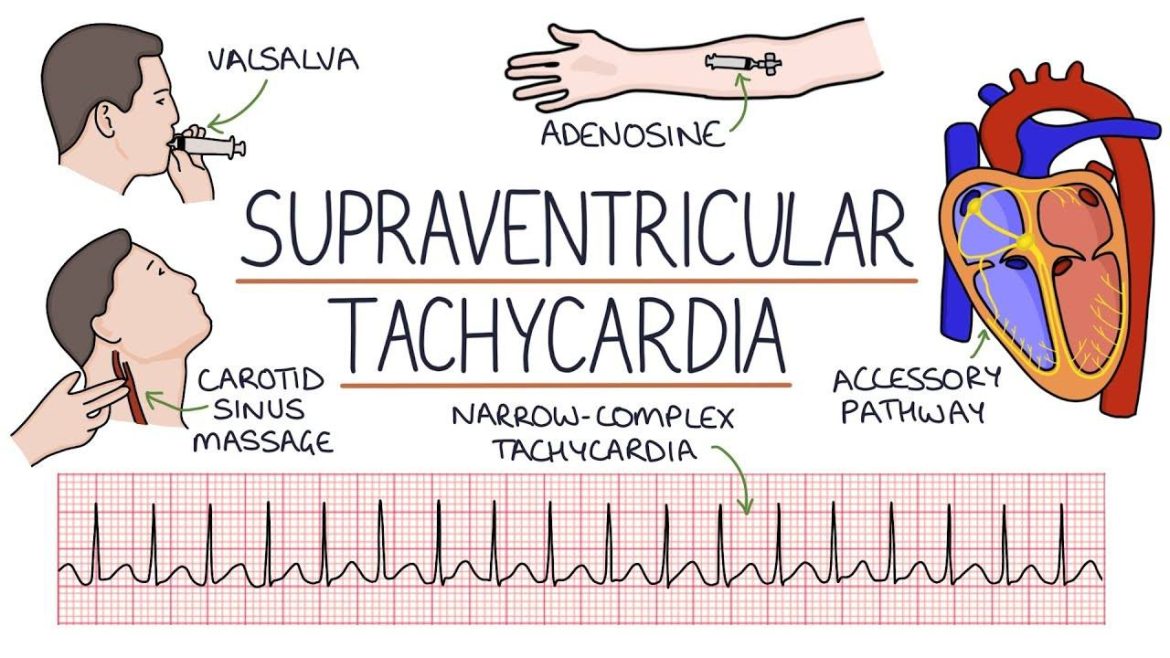Supraventricular tachycardia (SVT) is a rapid heart rate originating at or above the atrioventricular (AV) node. This condition is characterized by an abnormally fast heart rate, which can lead to a variety of symptoms and health concerns.
Understanding the rate at which SVT occurs, its implications, and how it is managed is crucial for both patients and healthcare providers.
What Is SVT?
SVT encompasses a range of arrhythmias, all of which share a common feature: their origin is above the ventricles of the heart. The term “supraventricular” literally means “above the ventricles.” The primary types of SVT include atrial fibrillation, atrial flutter, atrioventricular nodal reentrant tachycardia (AVNRT), and atrioventricular reciprocating tachycardia (AVRT).
Normal Heart Rate Vs. SVT
A normal resting heart rate for adults typically ranges from 60 to 100 beats per minute (bpm). During physical activity or stress, it is normal for the heart rate to increase. However, in SVT, the heart rate rises abnormally without an appropriate trigger, such as exercise. The heart rate in SVT can exceed 100 bpm, often ranging between 150 and 250 bpm, and it can occasionally reach even higher rates.
SEE ALSO: When Do Arrhythmias Usually Occur?
Threshold for SVT
While there is no strict cut-off, a heart rate above 100 bpm in an adult at rest is generally considered tachycardic. In the context of SVT, rates typically start from around 150 bpm. Here is a breakdown of the common rates associated with various types of SVT:
Atrial Fibrillation: Heart rates in atrial fibrillation can vary widely, but uncontrolled atrial fibrillation often exceeds 100 bpm and can reach up to 200 bpm.
Atrial Flutter: Typically presents with heart rates around 250-350 bpm in the atria, translating to a ventricular response rate of approximately 150 bpm when there is a 2:1 conduction ratio.
AVNRT: Usually results in a heart rate between 140 and 250 bpm.
AVRT (including Wolff-Parkinson-White Syndrome): Rates can range from 150 to 250 bpm.
Clinical Presentation And Symptoms
Patients with SVT may experience a variety of symptoms, depending on the heart rate, underlying health conditions, and individual response.
Common symptoms include:
Palpitations: A sensation of a rapid, fluttering, or pounding heart.
Dizziness or lightheadedness: Reduced cardiac output can lead to decreased blood flow to the brain.
Shortness of breath: Inadequate oxygen delivery due to rapid heart rate.
Chest pain: Especially in patients with underlying coronary artery disease.
Syncope or near-syncope: Fainting or feeling faint due to decreased cerebral perfusion.
Diagnosis of SVT
Diagnosing SVT typically involves several steps:
Patient History and Physical Examination: Identifying symptoms and potential triggers.
Electrocardiogram (ECG): The primary tool for diagnosing SVT, showing characteristic features such as rapid rate, narrow QRS complexes, and P waves that may be hidden or abnormal.
Holter Monitor or Event Recorder: Continuous ECG monitoring to capture intermittent episodes.
Electrophysiological Studies: Invasive testing to map the electrical activity of the heart and identify the precise origin of the arrhythmia.
Management of SVT
Management strategies for SVT depend on the type, severity, frequency of episodes, and the presence of underlying heart disease. Treatment options include:
Vagal Maneuvers: Techniques such as the Valsalva maneuver or carotid sinus massage can sometimes terminate an episode of SVT by stimulating the vagus nerve to slow the heart rate.
Medications: Antiarrhythmic drugs such as adenosine, beta-blockers, calcium channel blockers, or other medications may be used to control the heart rate or convert the rhythm to normal.
Cardioversion: Electrical or chemical cardioversion can be used in more severe cases or when medications are ineffective.
Catheter Ablation: A minimally invasive procedure where abnormal electrical pathways are destroyed using radiofrequency energy or cryotherapy.
Lifestyle Modifications: Avoiding known triggers such as caffeine, alcohol, and stress can help reduce the frequency of SVT episodes.
Prognosis And Long-Term Management
The prognosis for patients with SVT varies based on the type of SVT, the presence of underlying heart disease, and the effectiveness of treatment. Many patients can lead normal, healthy lives with appropriate management. However, ongoing monitoring and adjustments to treatment may be necessary.
Conclusion
What Rate is Considered SVT?
SVT is defined by a heart rate that typically exceeds 100 bpm, with most cases presenting between 150 and 250 bpm.
Recognizing the symptoms and seeking appropriate medical evaluation is crucial for effective management and to prevent complications. With advances in diagnostic and therapeutic techniques, patients with SVT can often achieve excellent outcomes and maintain a good quality of life. Understanding the nuances of heart rates in SVT is essentialfor both patients and healthcare providers in managing this common cardiac condition.

